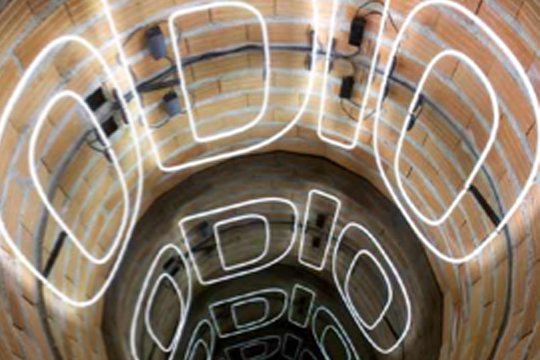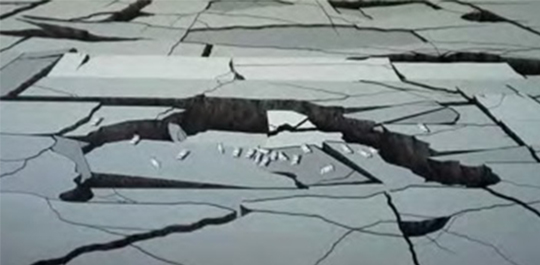CONTEMPORARY ISTANBUL: ALL ABOUT ASSERTION?
| May 10, 2013 | Post In LEAP 19

THIS JANUARY, AN exhibition of Damien Hirst’s “spin paintings” opened in Istanbul. Naturally, the news did not come lacking in controversy. The first solo show of one of contemporary art’s greatest heavyweights in Turkey was held not in a museum, but in the exhibition space of a local auction house— these were secondary works up for sale. A blog on Artinfo quickly published an article titled “Can Damien Hirst Save Istanbul? (Can Istanbul Save Damien Hirst?)” The most resounding provocation was two-fold: one, that contemporary art in Istanbul is behind the rest of the developed world; and two, that an artist like Damien Hirst, hated as much as he is admired, might emancipate local collectors and art enthusiasts from dire, tasteless straits. Yet for anyone who had been around the city just two months before, the implications were astoundingly misguided.
Or, at the very least, there are fewer reasons to be pessimistic about contemporary art’s status quo in Constantinople than there are reasons to be optimistic. In late November of 2012, the seventh rendition of Contemporary Istanbul (CI) was held in the sprawling Lütfi Kirdar convention center. Over 68,000 visitors perused the booths of 102 galleries, which hailed from a total of 72 countries. Parallel to this was the orchestration of the city’s first Art Week, Art Istanbul, which boasted the participation of over 50 museums, foundations, galleries, and other cultural organizations. On paper, any conversation about Damien and his relevance would seem, well, irrelevant. Istanbul has joined the prestigious ranks of the “international” art fair. (Note: Glocal vs. local discourse might not be better excused in any city than in Istanbul, the world’s only to span two continents.)
Of course, there was much evidence on hand that Istanbul still lags behind its Western counterparts. Echoing a quote from a prominent Turkish collector in the Artinfo article that “Turkish people love kitsch,” the offerings in many a local gallery booth were indisputably closer to home decoration than anything the educated enthusiast would dare deem contemporary art. Impressions of the less craft-heavy, more tastefully institutionalized made-in-Turkey wares on display were also of varied spectrum: one New York gallerist even went so far as to state that “Some of the work that I saw in the Turkish galleries was 10 years behind the foreign galleries in regards to contemporary art.”
Knowing this country’s struggle in recent years with jingoist leanings, one might have also, mistakenly or not, felt a looming sense of nationalism in CI’s layout, as most of the fairground’s prime first-floor real estate was allotted to Turkish galleries— a suspicion that was due not in small part to a notable preference of Turkish-speaking visitors for mingling upstairs as opposed to down. Most of the international galleries, no matter their renown, were to be found on the lower floor. Even worse, the “New Horizons” section, composed of galleries from Central and Eastern Europe, was relegated to a hidden half-floor, akin to the one in Being John Malkovich, complete with low ceilings and, as discerned by comments from certain Romanian exhibitors, feelings of paranoia.
Nonetheless, it was announced that “the total value of exhibited works amounted to more than USD 100 million, of which 66%, the equivalent of 2,500 works on display, were sold”— not bad for three days, and surely on par with the best of one-off contemporary art auction sales. According to official reports, these figures, as well as those for participating galleries, have grown consistently since CI’s inception. Beyond 2012’s participation of several of the industry’s more esteemed international pushers— Marlborough Gallery, Haunch of Venison, Andipa Gallery, and Galerie Michael Schultz, to name a few— the opening of new, year-round spaces in the city by others preceded the pride of this year’s through-sale numbers. New York-based Krampf Gallery even decided to shut down its Chelsea space and permanently relocate. One simple reason for the move, explains owner Regis Krampf, was that Istanbul “feels like New York in the 1980s.” He further extends this rationale to the very architecture of the city, to the old, narrow multistoried spaces that squeeze so much charm into the quaint cobbled lanes on which they reside.
Mostly gathered around the dense district of Beyoğlu, these lanes house several commercial and non-profit spaces that, CI or no CI, have alone help put the city on the map. Power galleries Rodeo, Rampa, NON, Galerist, Mana, SALT— these are names that are already familiar to many of the international art-world in-the-know. Newer spaces like the exchange-based Istanbul ’74 are also helping to pump up the city’s global clout. During CI 2012, the space collaborated with New York’s Marlborough Chelsea— the hip offshoot of the more modernist Marlborough, which also had a booth at Lütfi Kirdar— to host a solo exhibition of the hotly-tipped New York artist duo Jonah Freeman and Justin Lowe. James Cope from Marlborough Chelsea: “I really liked Istanbul and was very impressed with the scene. I met great collectors, artists and other dealers. There were great restaurants, cafes, nightclubs, etc. Great private collections.”

Cope also goes on to mention that Istanbul is a new market that is “basically untouched,” an expression that indicates the opposite will very soon be the case. Indeed, expectations for the future are high. Much of the official discourse surrounding CI and its ancillary events was rooted in the vocabulary of what’s-to-come. Before the 2012 edition had even opened, Contemporary Istanbul chairman Ali Güreli announced that the 2013 edition would be held concurrent with the (already well-reputed) Istanbul Biennial and would be accompanied by two brand-new fairs with a focus on photography, new media, and emerging artists and galleries. On the one hand, this might suggest blind belief in the invigorating blessings of the market. On the other, it reveals a confidence in this city’s potential— and confidence is, of course, the most important requisite for the foundations of any economy, scene, or any other collective endeavor.
But back to the premise of this article: that Istanbul has some catching up to do. Derya Demir of Galeri NON— a gallery that has done Istanbul a favor this past year by representing a solid roster of uncompromising talent at Frieze, Art HK, and Basel Miami— reacts thusly: “There is a misguided impression, perhaps generated by international press coverage, that there is an overall simplicity in the art scene here. On the contrary, the interest at home is also growing for international contemporary art, especially conceptual art. We see more and more collections driven by ideas each year. What’s more, each year more collectors are traveling for events like Documenta, Manifesta, international biennials and art fairs… The demand is not, as implicated, just for decorative art and/or blue-chip works, though evidently, as in many other countries around the world a large portion of galleries and collectors are indeed more into pretty things.” A ten-minute stroll through pretty much any art fair, anywhere, and one would be hard-pressed to argue. And if anybody is going to save anything, it will be Istanbul saving Damien— not the other way around.


